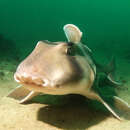Diagnostic Description
provided by Fishbase
Harness-like narrow dark stripes on back (Ref. 9838).
- Recorder
- Cristina V. Garilao
Life Cycle
provided by Fishbase
Oviparous. Distinct pairing with embrace (Ref. 205). Undergoes yearly migrations to breeding sites. Females lay about 10 to 16 (commonly 10-12) eggs in rock crevices on shallow sheltered reefs at depths of 1-5 m (rarely 20-30 m) during August and September (rarely in July and October). In captivity, females lay 2 eggs a day every 8-17 days. Eggs are hatched after 9-12 months and young then move into nursery areas in bays and estuaries. After the breeding season, males move into deeper waters followed by the females in late September or October.
Migration
provided by Fishbase
Oceanodromous. Migrating within oceans typically between spawning and different feeding areas, as tunas do. Migrations should be cyclical and predictable and cover more than 100 km.
- Recorder
- Kent E. Carpenter
Morphology
provided by Fishbase
Dorsal spines (total): 2; Dorsal soft rays (total): 0; Analspines: 0; Analsoft rays: 0
- Recorder
- Cristina V. Garilao
Trophic Strategy
provided by Fishbase
Occurs on the continental shelf (Ref. 75154).
Biology
provided by Fishbase
A common shark of the continental shelves (Ref. 9838), from close inshore at the intertidal zone to 275 m (Ref. 6871). Segregates by sex and maturity stage (Ref. 6871). Nocturnal, hides in caves and rocky gullies during the day (Ref. 6871). Feeds on benthic invertebrates, primarily echinoderms (Ref. 247). Oviparous (Ref. 50449). Eggs with spiral flanges but lack tendrils (Ref. 6871). Undergoes yearly migrations to spawning sites during breeding season (Ref. 247). Considered harmless to people, but can deliver a painful nip when provoked (Ref. 247).
- Recorder
- Kent E. Carpenter
Importance
provided by Fishbase
fisheries: minor commercial; aquarium: public aquariums; price category: unknown; price reliability:
- Recorder
- Kent E. Carpenter

